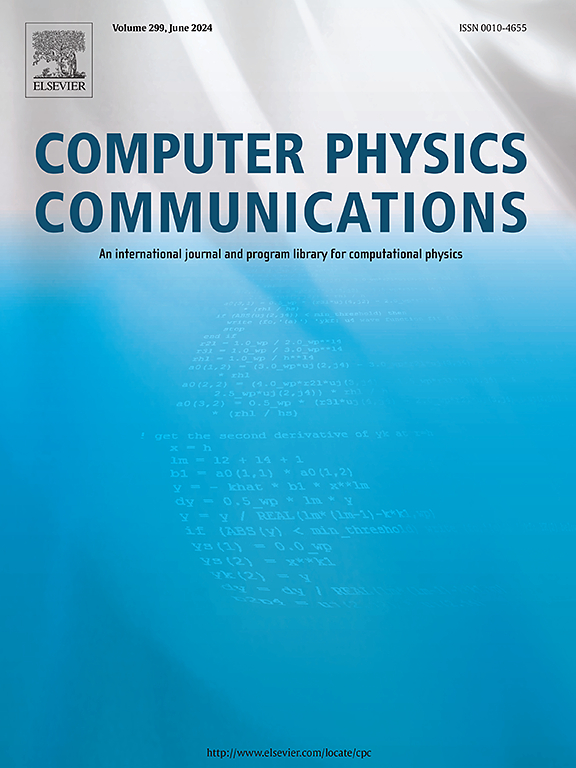利用基函数生成的数据训练神经算子预测辐射分布
IF 7.2
2区 物理与天体物理
Q1 COMPUTER SCIENCE, INTERDISCIPLINARY APPLICATIONS
引用次数: 0
摘要
通过输运方程的解来预测辐射相关的量分布是一个计算密集型的过程,需要大量的计算资源。神经网络有望实现快速预测;然而,它们的效用受到训练数据集稀缺性的限制。在本研究中,我们引入了一种使用傅里叶神经算子(FNO)预测辐射分布的方法,通过基函数生成数据,减轻了与有限数据集相关的挑战。我们的数值实验以PET-CT检查中光子沉积能量分布的预测为例。在基函数生成的数据集上训练的fno的性能与在CT图像数据集上训练的fno相当。具体而言,基于基函数生成的数据集训练的FNOs的平均绝对误差(MAEs)小于CT图像训练的3D U-Nets的平均绝对误差(MAEs)的65%,后者通常用于核医学领域的剂量分布预测。FNOs的推理时间约为0.1秒,明显快于Monte Carlo模拟的时间。我们的发现强调了FNOs在基函数生成数据上训练的泛化能力。这为辐射场的快速预报提供了一条实用的途径。此外,利用基函数生成数据集的策略可以有效地克服可用数据集稀缺的局限性。本文章由计算机程序翻译,如有差异,请以英文原文为准。
Predicting radiation distribution via neural operator trained on basis function-generated data
The prediction of radiation-related quantity distributions through the solution of the transport equation is a computationally intensive process that necessitates substantial computational resources. Neural networks hold promise for rapid prediction; however, their utility is constrained by the scarcity of training datasets. In this study, we introduce a method using the Fourier Neural Operator (FNO) to predict radiation distributions, mitigating the challenges associated with limited datasets by generating data through basis functions. Our numerical experiments use the prediction of photon-deposited energy distributions in PET-CT examinations as an example. FNOs trained on datasets generated by basis functions show performance comparable to those trained on data derived from CT images. Specifically, the Mean Absolute Errors (MAEs) of FNOs trained on basis function-generated datasets are less than 65% of the MAEs of 3D U-Nets trained on CT images, which are commonly utilized for dose distribution prediction in the field of nuclear medicine. The inference time of FNOs is approximately 0.1 seconds, which is significantly quicker than the time taken for Monte Carlo simulations. Our findings underscore the generalization abilities of FNOs trained on basis function-generated data. This indicates a practical approach for the rapid prediction of radiation fields. Moreover, it suggests that the strategy of generating datasets using basis functions can effectively overcome the limitations caused by the scarcity of available datasets.
求助全文
通过发布文献求助,成功后即可免费获取论文全文。
去求助
来源期刊

Computer Physics Communications
物理-计算机:跨学科应用
CiteScore
12.10
自引率
3.20%
发文量
287
审稿时长
5.3 months
期刊介绍:
The focus of CPC is on contemporary computational methods and techniques and their implementation, the effectiveness of which will normally be evidenced by the author(s) within the context of a substantive problem in physics. Within this setting CPC publishes two types of paper.
Computer Programs in Physics (CPiP)
These papers describe significant computer programs to be archived in the CPC Program Library which is held in the Mendeley Data repository. The submitted software must be covered by an approved open source licence. Papers and associated computer programs that address a problem of contemporary interest in physics that cannot be solved by current software are particularly encouraged.
Computational Physics Papers (CP)
These are research papers in, but are not limited to, the following themes across computational physics and related disciplines.
mathematical and numerical methods and algorithms;
computational models including those associated with the design, control and analysis of experiments; and
algebraic computation.
Each will normally include software implementation and performance details. The software implementation should, ideally, be available via GitHub, Zenodo or an institutional repository.In addition, research papers on the impact of advanced computer architecture and special purpose computers on computing in the physical sciences and software topics related to, and of importance in, the physical sciences may be considered.
 求助内容:
求助内容: 应助结果提醒方式:
应助结果提醒方式:


